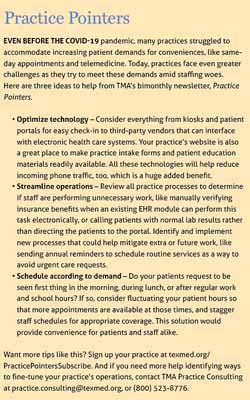
North Texas family physician Jamison Albracht, DO, began modernizing his practice well before the COVID-19 pandemic – in 2007, in fact.
Although no one could predict how technology would change health care over the next 16 years, Dr. Albracht and his colleagues recognized at the time that the world was changing. Following the release of the first iPhone, they knew they needed to update their services to remain relevant and thrive in an ever-changing medical landscape.
“When we formed Village Health Partners, we decided that our three brand promises would be access, convenience, and quality medical care,” Dr. Albracht said. “Nobody understood just how access would evolve when we first formed that statement.”
Only a few years prior, the Institute of Medicine named “patient-centered care” as one of six fundamental goals of the U.S. health care system. The move came as e-commerce companies like Amazon emerged, later followed by the likes of Uber, offering consumer conveniences across multiple industries.
Fast forward and that demand has only hastened, including in health care. As a result, practices are evolving to survive and thrive in a marketplace saturated with options.
Earlier this year, Amazon acquired One Medical, a concierge primary care company with nine locations in Texas. Additionally, competitors like urgent care centers and retail clinics, including Walmart Health and CVS MinuteClinics, are constantly updating to meet patient demands. And public and private payers continue to look at patient satisfaction as a component of value-based payment.
Speed and accessibility have become the greatest interests for patients, says the State of Patient Access 2023 report from Experian Health. “Seeing a practitioner quickly” was the No. 1 concern on patients’ “most challenging” list for the past three years – a concern often aggravated by a lack of patient portals and online scheduling.
“Today, there is an expectation for health care services to match the convenience of companies like Amazon,” Dr. Albracht said. “If I can order a product and have it at my doorstep within minutes, why not get health care the same way?”
As a millennial physician coming out of residency, Stefan Huber, DO, is used to technology “and what it can offer us, which is the instant access we’ve all become used to,” he said. “Having a little more access can go a long way.”
With that philosophy in mind, Dr. Huber and his partner, family physician Aaron Kolar, DO, plan to open a practice next month in Waco with modern amenities Dr. Huber sees as important nowadays to thrive in a competitive market: online scheduling, walk-in appointments, telemedicine visits, on-site lab work, electronic health records (EHRs), and longer hours.
Dr. Huber believes that by offering these services, their practice can build lasting patient-physician relationships – while keeping the community happy and healthy.
“We don’t want to stay stagnant, especially as health care can change so vastly in such short periods of time,” he said.
“I want to be so accessible that patients come to us, not the hospital. Access is changing the way we do medicine. There’s no stopping it. Physicians need to get on board, from data analytics to text campaigns, or someone else will.”

The cost of convenience
The cost of meeting those demands, however, can be a barrier for smaller, private practices like that of Dr. Huber and Dr. Kolar, who has been practicing in Weatherford.
“Realistically, modern services cost a lot of money,” Dr. Huber said. “There were many nights that my wife and I, and my partner and his wife, stayed up to discuss the realities of opening a practice. We would ask ourselves, ‘Is this worth it?’”
A study by Health Affairs found that the typical multiphysician practice will spend roughly $162,000 to implement an EHR, with $85,000 going toward first-year maintenance costs. Moreover, practices that choose to build in-house labs can expect to pay $100,000 or more – and that’s if they already have the appropriate space and excludes additional costs for construction, permits, specialized equipment, a medical lab manager, and a Clinical Laboratory Improvement Amendments (CLIA) certification, for instance.
While the upfront cost may be daunting, practices like the one Drs. Kolar and Huber will open are finding such conveniences may be more affordable, and worthwhile, than they appear.
“Cost is what you what you make it to be. One of our main goals is to be as efficient as possible, and we knew that services like our lab are huge for convenience and for managing the patient to the best of our ability. So, we started looking at options,” Dr. Kolar said.
In-house labs can generate another revenue stream within a practice while providing a competitive edge that attracts new patients.
For Village Health Partners, bringing tests in house provided data that helped the practice avoid unnecessary interventions, while providing revenue that otherwise would go toward outsourcing those tests.
To determine affordability and which tests to offer, the practice took inventory of its patients’ needs, especially specialized needs, and ultimately worked with a lab that provided equipment to treat a wide variety of patients.
“We’ve tried to put together the services that patients would need and get it done in a timely fashion at the same place,” Dr. Albracht said. “This is one part of that.”
To offset costs further, Drs. Huber and Kolar worked with the Texas Medical Association’s Practice Consulting, which aided with CLIA certification, clinic build, and staff recruitment. (See “Priority: Practice Viability,” p. 22.)
“The TMA consultant team accumulated data on internal and family medicine doctors in this region, and our consultant came back to us and said that our projections show us as being a successful clinic,” Dr. Kolar said. “This really helped with mitigating apprehension.”
Additionally, the pair joined a group purchasing organization that negotiates better manufacturer prices for its members. Usually, physicians who join group purchase organizations will commit to purchasing a specific percentage of annual supplies from the organization. In return, they get lower pricing on necessities like tables, otoscopes and lab supplies, staff health insurance, even credentialing.
The two also will use an EHR services company that takes a percentage of their gross collections instead of a monthly fee, which made opening a practice more affordable. According to Health Affairs, practices can expect to cover the cost of an EHR in about two and a half years.
They took out a small business loan to build their practice, which caused “lots of anxiety” initially, Dr. Huber said. But he believes the decision will pay off in the long run.
“It’s an investment not unlike going to medical school. We took out student loans to invest in our future – we look at our practice in the same way.”
Staying plugged in
Investments in digital amenities are another must, especially since the pandemic.
The U.S. Office of the National Coordinator for Health IT found increased patient portal usage and online medical record download rates during the pandemic. In 2020, about six in 10 individuals nationwide were given patient portal access, and nearly 40% accessed their records at least once.
And 56% of patients said they would switch practices because of a lack of accessibility, per the State of Patient Access 2023 report. Village Health Partners was fortunate to have equipped itself with services like telehealth, online scheduling, and a patient portal before the pandemic, and embracing digital access allowed the practice to thrive throughout it.
“Above all, we always want to provide access,” Dr. Albracht said. “Because we had modernized beforehand and had telehealth infrastructure already in place, we were able to take care of patients in a way that felt very safe and comfortable during the pandemic, while other practices in the area struggled to transition.”
The portal allowed patients to book and cancel appointments at their discretion for minimal practice costs, removing headaches like having to phone and possibly wait on hold – reducing burden for both patient and physician.
By opening the lines of communication, Village Health Partners saw old patients returning – and new patients coming in.
“Everything we do is about evolving to what we see as high patient experience and streamlining the process for appointments for patients that are used to convenience,” Dr. Albracht said. “At the end of the day, I’d much rather have patients access their portal than have them waiting on the phone trying to get ahold of us.”
According to the American Medical Association, physicians receive 57% more patient portal messages than they did prior to the pandemic, which can contribute to burnout. But AMA also points to inbox-reduction tools practices can adopt to triage such messages based on importance and assign certain tasks to staff.
And Dr. Albracht attests that the portal also can help reduce administrative errors, no-shows, and denied claims, further lightening his practice’s workload.
It’s also integrated with the new nontraditional “waiting room” feature the practice now employs, in addition to offering appointments seven days a week. Through the platform, patients are instructed to check in for appointments online or, if they have questions, with the concierge at the front desk. Once they’ve arrived for their visit, patients are texted their room number within the practice and allowed to head straight there – all without having to wait or interact with others.
While some patients find the system too automated for their preferences, says Dr. Albracht, the majority have grown to embrace it.
“The majority of our patients, about over 90% in our surveys, will say they love the way that this system allows more independence and privacy. It’s on their time, versus the physicians’ time. And what costs more than time?” he asked. “Every transition we’ve made has been for the better for our organization and patients. And it’s an opportunity to see how your organization can change and do what’s necessary to take care of the patient.”
Dr. Kolar agrees.
“There’s apprehension about physician burnout, but while it might be a little bit more work upfront, it’s worth it to develop the patient care that we dream of,” he said.